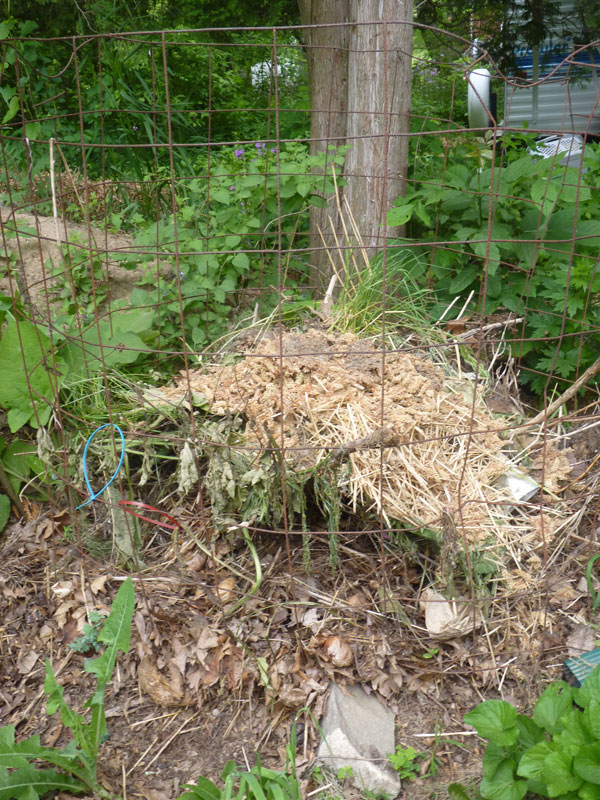Composting is a very easy way to integrate natural processes and nutrients into your garden, flower beds, and life. While various statistics exist, most commonly, I’ve seen statistics that suggest that up to 50% of what we throw away in the USA is food items or items that are biodegradable. These are items, like vegetables or stems, that come out of the nutrients in the system. Americans also like to rake up/bag up and throw away their lawn clippings, “weeds”, etc. By sending them into a landfill, we lock those nutrients away and don’t allow them to cycle through the system again. So composting is an important part of shifting to a more sustainable practice and allows us to build great soils in the process. By composting, I was able to reduce what I threw away/put on the curb by almost 50%–and now I know how much I was wasting.
Over the last three years, I’ve been experimenting with a number of composting methods. I currently am the composting site for three families (including my own). As such, I’ve worked to develop a number of different composting strategies. All of the strategies that I’ll present here work in combination with each other for different kinds of composting at different speeds.

Sheet Mulching – Direct Composting in Garden Beds
Materials you can compost: Fall leaves, yard waste, leftovers from last year’s garden (corn stalks, tomato plants, etc.). Grass clippings, provided they come from a pesticide-free yard (get them from the one that still has dandelions)!
How to do it: In a previous post, I detailed how sheet mulching (preparing new garden beds or adding nutrients to existing garden beds). Sheet mulching is a great approach because it really only requites you to move the material once–you just lay it in place and the beds make themselves over time. I really like this approach and use it throughout my homestead.

Compost Tumbling- Keeping the Critters Out and the Nutrients In!
Materials you can compost: Any food waste (except meats and cheeses), yard waste, garden leftovers.
How to do it: For compost tumbling, you’ll want to get a compost tumbler. You can make one relatively cheaply from an old barrel (fill it up and roll it around the yard) or you can purchase a nice one. I bought one that is insulated, which theoretically allows one to compost in the winter…..or not. In hindsight, I would have just made one myself out of recycled materials, such as an old 50 gallon pickle barrel. I find that my compost tumbler takes about 2-3 months to produce a nice compost (and mine has two sides, so you let one compost down while filling the other one).

The Traditional Open Compost Pile
Materials you can compost: Any food waste (except meats and cheeses), yard waste, garden leftovers.
How to do it: A compost pile is the simplest form of compost. You just pile stuff up, wait, and if you are feeling really ambitious, turn it over every once in a while. I started with a compost pile, but my neighbors dog started coming over, eating out of my pile, and then pooping all through my yard. So I bought a compost tumbler. You can prevent your neighbor’s dog from engaging in his nefarious behavior by using palates or scrap wood to create a bin that isn’t accessible from the outside.


Worm Composting (Vermicomposting)
Materials you can compost: Food scraps, mainly.
How to do it: In February, our permaculture group had a skill share on vermicomposting (and this is the link to a video). Since I provided the materials for the worm composter, I was able to get it at the end of the skill share. I placed it in kitchen and its been working really well. The best thing about it was that I was able to find all of the materials in my garage, and the worms were donated to me by my friend, so it literally had no upfront cost. You *can* go out and buy expensive worm bins, or you can just use the methods that are in the video (which consist of two opaque tubs, drilling some holes, adding some wet shredded newspaper, adding some worms, and adding food scraps). The best thing about it is that you can compost this way year round, and you get AWESOME worm castings.

The Chicken Method: Let the Birds Do the Work!
Materials: Food scraps, old moldy bread, yard scraps, pretty much anything. We’ve given ours moldy cheese, old sauerkraut, leftovers from going out to eat, even the carcasses and bones of chicken, pork, etc. They eat it all.
How to do it. This last method is now my preferred method of composting! For this, you need Chickens in an enclosed coop. I had my chickens free ranging, which means they help keep the bug populations down. However, they were destroying the mulching around my perennial beds and I also lost the two bantams (smaller breed chickens) to hawks. So I built them a larger coop, and with the advice of a friend, started “chicken composting.” Basically the way it works is this–you put whatever you want the chickens to compost in the coop. Most of this they eat, and in a matter of hours, produce a nitrogen-rich dung (which needs to sit about 6 months or it will burn plants, its so high in nitrogen!) What they don’t eat attracts flies and worms, which they do eat. I also throw a ton of unshredded fall leaves in there, especially ones like oaks that are harder to compost down. What you end up with is a wonderful tilled up hummus, straight from the chickens, with minimal work.




Reblogged this on Tunnel to the Underground.
This is fantastic stuff, we have a “traditional open compost pile” which is emclosed It has not been working very well but since I last saw it, I think it has been upgraded. Lavender is also good for Sheet Mulching. I’ll take the chicken method into account, as you also get fresh eggs as a bonus.
Vagasivis, in what way do you use lavender? Do you mean the plants leftover at the end of the year? I usually make sachets and dryer bags (like for your clothes dryer) out of them :). Try the chicken method–its awesome! Thanks for the comment :).
Oh, we do that aswell. but then we use the left over long stem/stalk growth. I’ll suggest the chicken method when I get back home.
Reblogged this on Naturally Bubbly's Blog and commented:
If you have ever struggled making compost in your city garden like I have, this post from The Druid’s Garden gives you some simple easy to implement strategies!